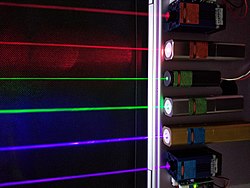Laser science


Laser scienceorlaser physicsis a branch ofopticsthat describes the theory and practice oflasers.[1]
Laser science is principally concerned withquantum electronics,laser construction,optical cavitydesign, the physics of producing apopulation inversioninlaser media,and the temporal evolution of the light field in the laser. It is also concerned with the physics of laser beam propagation, particularly the physics ofGaussian beams,withlaser applications,and with associated fields such asnonlinear opticsandquantum optics.
History
[edit]Laser science predates the invention of the laser itself.Albert Einsteincreated the foundations for the laser andmaserin 1917, via a paper in which he re-derivedMax Planck’s law of radiation using a formalism based on probability coefficients (Einstein coefficients) for theabsorption,spontaneous emission,andstimulated emissionof electromagnetic radiation.[2]The existence of stimulated emission was confirmed in 1928 byRudolf W. Ladenburg.[3]In 1939, Valentin A. Fabrikant made the earliest laser proposal. He specified the conditions required for light amplification using stimulated emission.[4]In 1947,Willis E. Lamband R. C. Retherford found apparent stimulated emission in hydrogen spectra and effected the first demonstration of stimulated emission;[3]in 1950,Alfred Kastler(Nobel Prize for Physics 1966) proposed the method ofoptical pumping,experimentally confirmed, two years later, by Brossel, Kastler, and Winter.[5]
The theoretical principles describing the operation of a microwave laser (a maser) were first described byNikolay BasovandAlexander Prokhorovat theAll-Union Conference on Radio Spectroscopyin May 1952. The first maser was built byCharles H. Townes,James P. Gordon,andHerbert J. Zeigerin 1953. Townes, Basov and Prokhorov were awarded theNobel Prize in Physicsin 1964 for their research in the field of stimulated emission.Arthur Ashkin,Gérard Mourou,andDonna Stricklandwere awarded the Nobel Prize in Physics in 2018 for groundbreaking inventions in the field of laser physics.[6]
The first working laser (a pulsedruby laser) was demonstrated on May 16, 1960, byTheodore Maimanat theHughes Research Laboratories.[7]
See also
[edit]References
[edit]- ^Taylor, Travis S. (2020).Introduction to laser science and engineering(1st ed.). Boca Raton London New York: CRC Press, Taylor & Francis Group.ISBN978-1-138-03639-0.
- ^Einstein, Albert (1917). "Zur Quantentheorie der Strahlung" [On the Quantum Theory of Radiation] (in German).
{{cite journal}}:Cite journal requires|journal=(help) - ^abSteen, W. M. "Laser Materials Processing", 2nd Ed. 1998.
- ^Batani, Dimitri (2004)."Il rischio da laser: cosa è e come affrontarlo; analisi di un problema non così lontano da noi"[The risk from laser: what it is and what it is like facing it; analysis of a problem which is thus not far away from us.].Programma Corso di Formazione Obbligatorio Anno 2004(in Italian). Archived fromthe original(Powerpoint)on June 14, 2007.RetrievedJanuary 1,2007.
- ^"The Nobel Prize in Physics 1966".Presentation Speech by Professor Ivar Waller.RetrievedOctober 17,2010.
- ^"The Nobel Prize in Physics 2018".Nobel Foundation.Retrieved2 October2018.
- ^Townes, Charles Hard."The first laser".University of Chicago.RetrievedOctober 17,2010.
- ^Taylor, Travis (20 August 2019).Introduction to Laser Science and Engineering(1st ed.). Boca Raton: CRC Press.doi:10.1201/b22159.ISBN9781315178561.S2CID201244143.RetrievedJanuary 25,2021.
